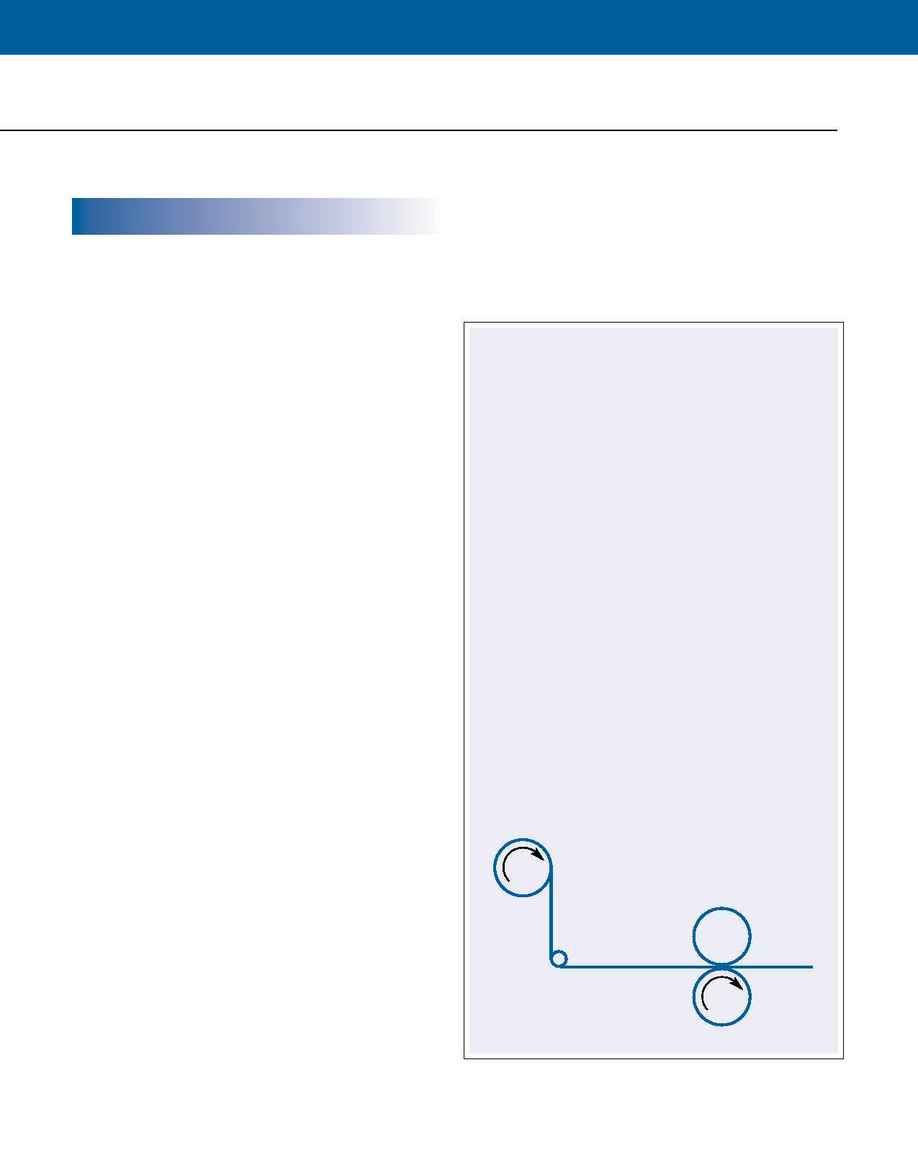
TECHNICAL REFERENCE
APPLICATION EXAMPLES
WEB TENSION CONTROL
Web processing applications often require tension control.
In the most demanding case, the web is pulled by an inde-
pendent process which may be continuous or start/stop. The
web tension is sensed by a load cell. The requirement is to
supply the web from a feed roll under constant tension. The
same process applies to winding the web on a take-up roll
under constant or variable tension.
Requirements
Speed of master: 0-20 inches/sec, start/stop
Master encoder resolution: 400 counts/in
Feed roll diameter: 3.5 - 16 inches
Feed roll encoder resolution: 10,000 counts/rev
Load sensor output: 010V for 0 20 oz
Tension accuracy: ±0.5 oz
Components Selected
DMC-2020: Controller
ICM-2900: Interconnect module
WSDK: Servo design software
Operation
The length of the web pulled by the master process is moni-
tored by an encoder with a resolution of 400 counts/in. The
feed roll is driven by a motor with a tachometer and an
encoder of 10,000 counts/rev. The motor is driven by an
external amplifier. Due to the heavy inertial load, the ampli-
fier is configured in velocity mode for added stability.
The feed-roll motion is divided into two parts: coarse
and fine motion. The coarse motion is achieved by gear-
ing the feed roll to the master process and continuously
estimating the gear ratio. This mode performs most of the
required motion but not all of it because the ratio is not
known precisely.
The fine motion consists of corrective moves superim-
posed on the electronic gearing signal. The errors in tension
are monitored and the motor is driven to the correct speed.
It is assumed that the initial gear value G is known.
The initial value can be computed or measured directly.
The gear ratio may be continuously estimated by deter-
mining the ratio of the frequencies of the two encoders
and filtering that ratio.
In the following program, the feed-roll motor is con-
trolled by the X axis and the master is monitored by the Y
axis. The program consists of two parts: #GEAR which esti-
mates the gear ratio then performs the coarse move and
#TRIM which performs the fine move. The two programs
are executed simultaneously by multitasking.
FEED
ROLL
X
LOAD CELL
INSTRUCTION
INTERPRETATION
#INITIAL
Label
G=0
Define G
GAY
Set Y as master
GRG
Initial gear ratio
JG0
Initial jog speed
BGX
Begin motion
XP = _TPX
Read initial X position
YP = _TPY
Read initial Y position
#GEAR
Y = _TPY
Read new Y
X = _TPX
Read new X
JP #GEAR, Y = YP
Repeat if no Y motion
DX = X - XP
Compute X increment
DY = Y - YP
Compute Y increment
XP = X
Update X position
YP = Y
Update Y position
RATIO = DX/DY
Ratio of increments
G = (G*7+RATIO)/8
Estimate gear
GRG
Update gear
JP#GEAR
Repeat cycle
EN
#TRIM
Label
E = @AN[1]-4
Tension error
JG E*20
Fine jog speed
JP #TRIM
Repeat
EN
End program
Example--Web Tension Control
WEB TENSION CONTROL
The load cell signal is applied to the analog input #1
and the required sensor level is 4 V. Accordingly, the dif-
ference E between the sensor output and 4 is the error in
tension. The motor is required to jog at a speed that is
equal to 20 times E.
96
·
Galil Motion Control, Inc.
·
www.galilmc.com
